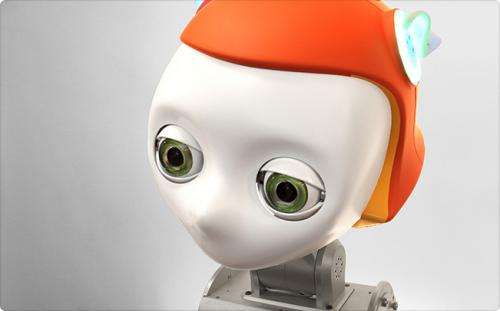October 14, 2011 report
Meka's robot head makes eyes at next-wave users (w/ video)

(PhysOrg.com) -- You've seen robots in the form of alpha dogs and insect swarms capable of military deployments but the next wave of robotics also includes a special breed of "sociable" robots for use in medicine, eldercare, and education. These are the robots that demand scientists’ skills toward making robotic parts that can mimic their human counterparts, and be responsive to social cues.
Small wonder that human heads were turning last month at the IROS (Intelligent Robots and Systems) 2011 event in San Francisco where visitors met the most sociable humanoid head around, attached to a torso and arm assembly. The robot belongs to Professor Luis Sentis of University of Texas at Austin.
The Meka robot goal was to design a head that can elicit a sense of trust and sociability. In viewing the head, it is difficult not to feel an affinity, even though the head is not at all truly representational of a human head but rather is a curious blend of anime and cartoon character searching for a DreamWorks home.
The head carries much expressiveness and the focal resting points are the engaging eyes. Meka co-founder Aaron Edsinger fielded questions about the robot at the event, and provided technical details: The humanoid head is a seven degree-of-freedom robotic active vision head. Designed for a wide range of expressive postures, it is a useful platform for researchers interested in human-robot interaction and social robotics.
The system features high resolution FireWire cameras in each eye, integrated DSP controllers, zero-backlash Harmonic Drive gearheads in the neck, and Meka M3 and ROS software stacks. When asked why the little ears, he answered, "That was my idea. I had a puppy, so they were inspired by that."
Edsinger also noted that the robot involved the Meka team and the Human Centered Robotics Group at UT Austin. At UT Austin, Professor Luis Sentis is known for his work with force augmentation, which looks into how robots can help to augment the movements of humans. ”We worked closely with Professor Sentis to achieve a friendly anime aesthetic for the overall look, adding two 2DOF ears with RGB lighting for added expressive ability.”
Meka Robotics, in addition to the humanoid head, offers specialized parts--hands, grippers, arms, torsos. The company supports the Willow Garage Robot Operating System (ROS), an open source platform for personal robots, including RVIZ kinematic visualization, URDF descriptions, posture control of all joints, and common sensor interfaces.
Meka is a 2006 spin-off from the MIT Computer Science and Artificial Intelligence Lab, where its founders, Edsinger and Jeff Weber, developed the Domo humanoid robot. Weber’s work with prosthetic ankles and knees at the MIT Media Lab led to the first commercially available powered prosthetic ankle.
More information: mekabot.com/
© 2011 PhysOrg.com



















